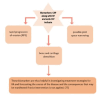Role of C-reactive protein in disease progression, diagnosis and management
- PMID: 39554800
- PMCID: PMC11569793
- DOI: 10.15190/d.2023.18
Role of C-reactive protein in disease progression, diagnosis and management
Abstract
C-reactive protein (CRP) is a ring-shaped pentameric protein synthesized in the liver via CRP gene transcription. It is an inflammatory marker, whose serum levels can be measured using traditional and high-sensitivity tests. In healthy adults, the normal CRP serum concentrations vary between 0.8 mg/L and 3.0 mg/L. These can be grouped into low-, moderate-, and high-risk categories according to CRP levels of less than 1, 1-3, and greater than 3 mg/L, respectively. Elevated levels have been observed in infections, autoimmune diseases, neurodegenerative disorders, and malignancies. However, it is not specific to any disease. Serum CRP levels have also been shown to indicate the risk of cardiovascular disease, owing to their role as inflammatory markers in atherosclerosis, coronary artery disease, and peripheral arterial disease. Furthermore, its role in autoimmune diseases, such as Systemic Lupus Erythematosus and rheumatoid arthritis, and its involvement in the development of cancers, including breast, colorectal, ovarian, prostate, and lung cancers, have also been studied. The involvement of CRP in determining the course of infection and differentiating between bacterial and viral infections has also been investigated. This review summarizes the published literature on C-reactive protein and its role in disease management and progression.
Keywords: Acute phase protein.; Biomarker; C-Reactive Protein; CRP; Inflammation.
Copyright © 2023, Ali et al., Applied Systems and Discoveries Journals.
Conflict of interest statement
Conflict of interests: The Authors declare that they have no conflict of interest.
Figures









References
-
- The physiological structure of human C-reactive protein and its complex with phosphocholine. Thompson Darren, Pepys Mark B, Wood Steve P. Structure. 1999;7(2):169-177. - PubMed
-
- Release of C-Reactive Protein in Response to Inflammatory Cytokines by Human Adipocytes: Linking Obesity to Vascular Inflammation. Calabro Paolo, Chang David W., Willerson James T., Yeh Edward T.H. Journal of the American College of Cardiology. 2005;46(6):1112-1113. - PubMed
-
- C-reactive protein and inflammation: conformational changes affect function. Wu Yi, Potempa Lawrence A., El Kebir Driss, Filep János G. Biological Chemistry. 2015;396(11):1181-1197. - PubMed
Publication types
LinkOut - more resources
Full Text Sources
Research Materials
Miscellaneous
